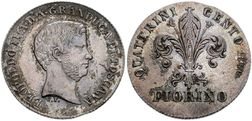Tuscan florin
| Tuscan florin | |
|---|---|
| fiorino (Italian) | |

One florin by Leopold II
|
|
| User(s) | |
| Subunit | |
| 1/100 | quattrino |
| Symbol | ƒ |
| Coins | q.1, q.3, q.5, q.10, q.20, p.1 ƒ1, ƒ2, ƒ4 |
| Rarely used | ƒ¼, ƒ½, ƒ20, ƒ60, ƒ80 |
| Mint | Florence Mint |
|
This infobox shows the latest status before this currency was rendered obsolete.
|
|
The florin (Italian: fiorino) was the currency of Tuscany between 1826 and 1859. It was subdivided into 100 quattrini (singular: quattrino), a local currency made by four pennies (from the Latin: quater denarii). There was an additional denomination called the paolo, worth 40 quattrini, in circulation.
Contents
History
During the Napoleonic Wars, Tuscany was annexed by France and the French franc was introduced, together with its satellite Italian lira. Previous Tuscan pound did not disappear, but a big confusion was created between the old pound (called lira in Italian) and the new lira. So, when Duke Leopold II rose to power in 1824, he decided to introduce a new basic currency. The florin replaced the Tuscan pound at a rate of 1⅔ pounds = 1 florin.[1] In 1847, Tuscany absorbed Lucca and the florin replaced the Luccan pound at a rate of 1 florin = 2 pounds. After a brief revolutionary coinage, the florin was replaced in 1859 by a provisional currency denominated in "Italian lira", equal to the Sardinian lira, with 1 florin = 1.4 Italian lire.
Coins
Copper coins were struck in denominations of 1 and 3 quattrini, together with billon 5 and 10 quattrini, silver ½, 1 and 5 paolo, ¼, ½, 1 and 4 florins. Gold coins included the sequin (Italian: zecchino), ruspone and 80 florins, the latter two equalled 3 and 10 sequins respectively.
References
- Lua error in package.lua at line 80: module 'strict' not found.
- ↑ This fact was quite obvious, because the pound was equivalent to 240 pennies or 60 quattrini, while the florin was equivalent to 100 quattrini or 400 pennies.